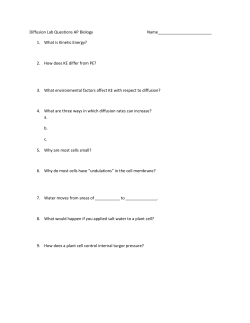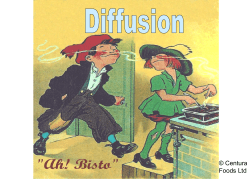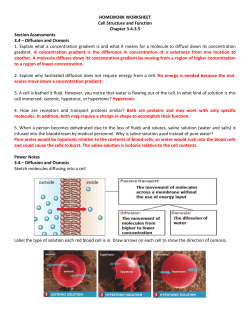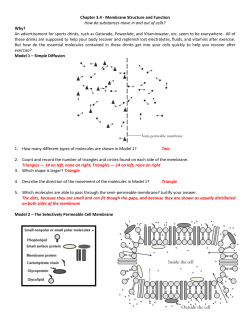
Analyzing the Effect of Cell Size on Diffusion Laboratory Exercise Wrap-Up
Analyzing the Effect of Cell Size on Diffusion Laboratory Exercise Wrap-Up Athenesia Faggins, PhD Candidate Temple University, Department of Biology The work reported herein was supported by the National Science Foundation, award # 0841377, through a grant to Temple University. The opinions expressed do not necessarily reflect the position of the supporting agencies and no official endorsement should be inferred. What is diffusion? • Diffusion is the movement of molecules from an area of high concentration to an area of low concentration • There are several types of diffusion – Simple Diffusion – Passive Diffusion – Active Transport Simple Diffusion: molecules move from an area of high concentration to areas of low concentration until equilibrium is reached Image: http://acsbiology.info/MovementSubstances.aspx Passive Diffusion: molecules move across a membrane from areas of high concentration to areas of low concentration until equilibrium is reached Image: http://acsbiology.info/MovementSubstances.aspx Laboratory Exercise: Analyzing the effect of cell size on diffusion • The purpose of this exercise was to demonstrate cell size as a potential limitation on diffusion efficiency – How efficiently a cell can exchange substances depends on the surface area-to-volume ratio Length Width Height Surface Area = (Length x Width) x 6 sides Volume = Length x Width x Height Ratio = Surface Area Volume Data Table 1. Cell Size Comparison: Dimensions Cube Length (cm) Width (cm) Height (cm) Small 0.5 0.5 0.5 Medium 1.0 1.0 1.0 Large 1.5 1.5 1.5 Data Table 2. Cell Size Comparison: Surface Area-to-Volume Ratio Cube Surface Area Volume (cm3) Surface (cm2) Area:Volume Small 1.5 0.125 12:1 or 12 Medium 6 1 6:1 or 6 Large 13.5 3.375 4:1 or 4 Cube Size (Dimensions) 0.5 x 0.5 x 0.5 1.0 x 1.0 x 1.0 1.5 x 1.5 x 1.5 Cube Size 0.5 x 0.5 x 0.5 1.0 x 1.0 x 1.0 1.5 x 1.5 x 1.5 Data Table 3. Cell Size Comparison: Rate of Diffusion Depth of Diffusion Time (min) Rate of Diffusion(cm/min) (cm) 0.1 10 0.01 0.1 10 0.01 0.1 10 0.01 Data Table 4. Cell Size Comparison: Efficiency of Diffusion Cube Volume of clear Volume of colored Percentage of cube Volume area (cm3) area (cm3) reached by diffusion (cm3) 0.125 0.027 0.098 78.4% 1 0.512 0.488 48.8% 3.375 2.197 1.178 35% Which cell is most efficient? Depth of diffusion = 1 mm Rate of diffusion = .1 mm/min Diffusion efficiency = 35% Depth of diffusion = 1 mm Rate of diffusion = .1 mm/min Diffusion efficiency = 50% Depth of diffusion = 1 mm Rate of diffusion = .1 mm/min Diffusion efficiency = 80% Why is the human body made up of billions of tiny cells, rather than one giant cell? EFFICIENCY!
© Copyright 2025





















